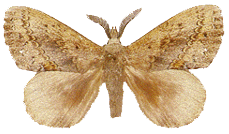|
Lajonquierea
jermyi sp. n
|

Lajonquierea
jermyi ♂
(paratype)
(natural
size)
|

|
♂♂32-33mm.
The species has the appearance of a large piccoloptera but is
distinguished by characters of the male genitalia. The aedeagus has a
massive ventral spine, the vesica slightly bilobed, each lobe with a basal
cluster of spines and more sparsely scattered ones distally. The cubile
arms are similar to those of poeciloptera but the apical bifurcations are
more splayed; the dorsal spur to the valves is more basal than in
poeciloptera, the valve itself longer, slender.
Holotype ♂
SARAWAK:
Gunong Mulu Nat. Park, R.G.S. Exped. 1977-8 (J.D. Holloway et al.) Site
14, February, Camp 2.5, Mulu, 1000m, 413461, [lower montane forest], MV
canopy/understorey. BM lasiocampid slide 1020.
Paratype ♂BRUNEI:
1670m, Bukit Pagon, montane forest, February 1982 (Allen & Harman), BM
lasiocampid slide 1025.
Geographical range. Borneo.
Habitat preference. The holotype was taken in lower montane forest, the
paratype in upper montane forest.
The species is named for Clive Jermy, Scientific Coordinator of the Mulu
Expedition.
<<Back
>>Forward <<Return
to Contents page
|

